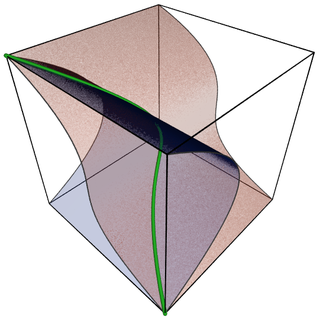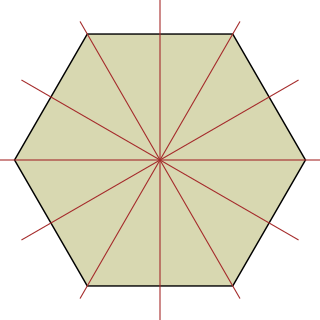
In mathematics, a Lie group is a group that is also a differentiable manifold, such that group multiplication and taking inverses are both differentiable.
In commutative algebra, the prime spectrum of a commutative ring R is the set of all prime ideals of R, and is usually denoted by ; in algebraic geometry it is simultaneously a topological space equipped with the sheaf of rings .

In mathematics, topological groups are the combination of groups and topological spaces, i.e. they are groups and topological spaces at the same time, such that the continuity condition for the group operations connects these two structures together and consequently they are not independent from each other.
In mathematics, a commutative ring is a ring in which the multiplication operation is commutative. The study of commutative rings is called commutative algebra. Complementarily, noncommutative algebra is the study of ring properties that are not specific to commutative rings. This distinction results from the high number of fundamental properties of commutative rings that do not extend to noncommutative rings.

In mathematics, genus has a few different, but closely related, meanings. Intuitively, the genus is the number of "holes" of a surface. A sphere has genus 0, while a torus has genus 1.
In mathematics, specifically in homology theory and algebraic topology, cohomology is a general term for a sequence of abelian groups, usually one associated with a topological space, often defined from a cochain complex. Cohomology can be viewed as a method of assigning richer algebraic invariants to a space than homology. Some versions of cohomology arise by dualizing the construction of homology. In other words, cochains are functions on the group of chains in homology theory.

In algebraic geometry and commutative algebra, the Zariski topology is a topology defined on geometric objects called varieties. It is very different from topologies that are commonly used in real or complex analysis; in particular, it is not Hausdorff. This topology was introduced primarily by Oscar Zariski and later generalized for making the set of prime ideals of a commutative ring a topological space.

Algebraic varieties are the central objects of study in algebraic geometry, a sub-field of mathematics. Classically, an algebraic variety is defined as the set of solutions of a system of polynomial equations over the real or complex numbers. Modern definitions generalize this concept in several different ways, while attempting to preserve the geometric intuition behind the original definition.
In algebra, ring theory is the study of rings—algebraic structures in which addition and multiplication are defined and have similar properties to those operations defined for the integers. Ring theory studies the structure of rings, their representations, or, in different language, modules, special classes of rings, as well as an array of properties that proved to be of interest both within the theory itself and for its applications, such as homological properties and polynomial identities.
Noncommutative geometry (NCG) is a branch of mathematics concerned with a geometric approach to noncommutative algebras, and with the construction of spaces that are locally presented by noncommutative algebras of functions, possibly in some generalized sense. A noncommutative algebra is an associative algebra in which the multiplication is not commutative, that is, for which does not always equal ; or more generally an algebraic structure in which one of the principal binary operations is not commutative; one also allows additional structures, e.g. topology or norm, to be possibly carried by the noncommutative algebra of functions.
In mathematics, specifically algebraic geometry, a scheme is a structure that enlarges the notion of algebraic variety in several ways, such as taking account of multiplicities and allowing "varieties" defined over any commutative ring.

In mathematics, a linear algebraic group is a subgroup of the group of invertible matrices that is defined by polynomial equations. An example is the orthogonal group, defined by the relation where is the transpose of .
In gauge theory and mathematical physics, a topological quantum field theory is a quantum field theory which computes topological invariants.
Algebraic K-theory is a subject area in mathematics with connections to geometry, topology, ring theory, and number theory. Geometric, algebraic, and arithmetic objects are assigned objects called K-groups. These are groups in the sense of abstract algebra. They contain detailed information about the original object but are notoriously difficult to compute; for example, an important outstanding problem is to compute the K-groups of the integers.

In mathematics, a topological space X is contractible if the identity map on X is null-homotopic, i.e. if it is homotopic to some constant map. Intuitively, a contractible space is one that can be continuously shrunk to a point within that space.
In mathematics and specifically in topology, rational homotopy theory is a simplified version of homotopy theory for topological spaces, in which all torsion in the homotopy groups is ignored. It was founded by Dennis Sullivan and Daniel Quillen. This simplification of homotopy theory makes certain calculations much easier.
In topology, a branch of mathematics, a prime manifold is an n-manifold that cannot be expressed as a non-trivial connected sum of two n-manifolds. Non-trivial means that neither of the two is an n-sphere. A similar notion is that of an irreduciblen-manifold, which is one in which any embedded (n − 1)-sphere bounds an embedded n-ball. Implicit in this definition is the use of a suitable category, such as the category of differentiable manifolds or the category of piecewise-linear manifolds.

Representation theory is a branch of mathematics that studies abstract algebraic structures by representing their elements as linear transformations of vector spaces, and studies modules over these abstract algebraic structures. In essence, a representation makes an abstract algebraic object more concrete by describing its elements by matrices and their algebraic operations. The theory of matrices and linear operators is well-understood, so representations of more abstract objects in terms of familiar linear algebra objects helps glean properties and sometimes simplify calculations on more abstract theories.
Mathematics is a broad subject that is commonly divided in many areas that may be defined by their objects of study, by the used methods, or by both. For example, analytic number theory is a subarea of number theory devoted to the use of methods of analysis for the study of natural numbers.
In mathematics, semi-simplicity is a widespread concept in disciplines such as linear algebra, abstract algebra, representation theory, category theory, and algebraic geometry. A semi-simple object is one that can be decomposed into a sum of simple objects, and simple objects are those that do not contain non-trivial proper sub-objects. The precise definitions of these words depends on the context.







